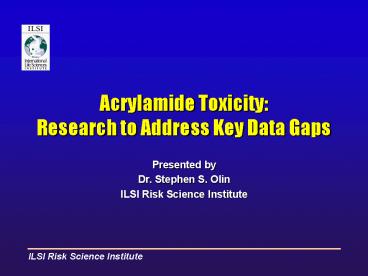Acrylamide Toxicity: Research to Address Key Data Gaps - PowerPoint PPT Presentation
1 / 17
Title:
Acrylamide Toxicity: Research to Address Key Data Gaps
Description:
Kinetics and Metabolism. Genetic Toxicity. Reproductive and ... Kinetics, Metabolism & Modes of Action: Research Needs ... Metabolism/kinetics in humans ... – PowerPoint PPT presentation
Number of Views:261
Avg rating:3.0/5.0
Title: Acrylamide Toxicity: Research to Address Key Data Gaps
1
Acrylamide ToxicityResearch to Address Key Data
Gaps
- Presented by
- Dr. Stephen S. Olin
- ILSI Risk Science Institute
2
JIFSAN/NCFST Workshop on Acrylamide in Food
- October 28-30, 2002 Chicago
- Mechanisms of Formation of Acrylamide in Food
- Analytical Methods
- Exposure and Biomarkers
- Toxicology and Metabolic Consequences
- Risk Communication
3
Toxicity Focus Areas
- Kinetics and Metabolism
- Genetic Toxicity
- Reproductive and Developmental Toxicity
- Carcinogenicity
- Neurotoxicity
- Epidemiology
4
Acrylamide Toxicology Research Themes
- Assess the significance of adverse effects
observed at high doses for low-level human
exposures in foods - Assess the significance for humans of effects
observed in vitro or in vivo in rodents
5
Kinetics, Metabolism Modes of ActionResearch
Needs
- Critical events and dose metrics related to modes
of action (MoA) for key acrylamide toxicities - Metabolic fate and kinetics in humans
- Physiologically-based pharmacokinetic models
6
Kinetics, Metabolism Modes of
ActionOngoing/Planned Research
- Critical events/dose metrics/MoA
- FDA/NCTR Linked to NTP bioassay
- NIEHS CYP 2E1 null mouse studies
- Metabolism/kinetics in humans
- Several groups RTI, CDC/NHANES, Stockholm U.,
Kaiserslautern U., others - PBPK models
- Kirman et al. (2003) Rat model others?
7
Genetic ToxicityResearch Needs
- Identification and characterization of adducts of
acrylamide and/or glycidamide with DNA and
significant nuclear proteins - Biological relevance
- Species and dose dependence, in vitro and in vivo
- Investigation of mechanisms of specific effects
(e.g., chromosomal effects, cell transformation)
8
Genetic ToxicityOngoing/Planned Research
- DNA and protein adducts
- FDA/NCTR DNA and protein adducts (including
dose response) - Industry DNA adducts in vitro and in vivo
- Genetic toxicity mechanisms
- FDA/NCTR - In vivo mutagenicity in Big Blue and
tk/- mice - Industry - Interaction with kinesin-related
proteins
9
Reproductive and Developmental Toxicity Research
Needs
- Dose-response data for germ cell toxicity in
rodents - Role of acrylamide vs. glycidamide
- Further examination of potential for
developmental neurotoxicity
10
Reproductive and Developmental Toxicity
Ongoing/Planned Research
- Germ cell toxicity
- NIEHS CYP 2E1 null mouse dominant lethal study
- Developmental neurotoxicity
- FDA/NCTR TBD
- Academic Mechanistic studies
11
CarcinogenicityResearch Needs
- Confirm and clarify carcinogenicity in standard
rodent models - Pathology working group review
- Assess effects of perinatal exposure
- Develop enhanced data for dose-response
assessment - Determine mechanisms of induction of key tumors
12
CarcinogenicityOngoing/Planned Research
- Clarify carcinogenicity
- NTP/NCTR Well-designed 2-year studies of
acrylamide in rats and mice - NTP/NCTR Neonatal mouse studies (acrylamide and
glycidamide) - NIEHS PWG review of previous studies?
- Mechanisms
- NTP/NCTR In conjunction w/2-year studies?
- Industry Thyroid, brain, cell proliferation
13
NeurotoxicityResearch Needs
- Relationships between dose, duration, and
effect-levels and onset of neurotoxicity - Determine effects of low-level, long-term dietary
exposures - Link damage at cellular/tissue level with
functional changes - Mechanisms of neurotoxicity
- Role of acrylamide vs. glycidamide vs. ?
- Bridge effects in animals and humans
14
NeurotoxicityOngoing/Planned Research
- Dose/duration/effect/onset
- FDA/NCTR Ancillary studies with 2-year rodent
bioassays to assess cumulative damage from
low-level dietary exposures? - Mechanisms -
- Academic Nerve terminal damage, axonal
transport, key proteins, etc. - NIEHS CYP 2E1 null mouse, antioxidant, Phase II
enzyme inhibitor - NIOSH Markers in exposed workers
15
EpidemiologyResearch Needs
- Study new or previously evaluated exposed worker
cohorts for specific effects - Link biomarkers of exposure with effects in
workers - Assess feasibility and design criteria for study
of acrylamide exposure/effects in
non-occupationally exposed populations
16
EpidemiologyOngoing/Planned Research
- Specific effects in workers
- NIOSH Reproductive and neurobehavioral
- Industry Reassessment of published studies
- Biomarkers
- NIOSH Biomarkers included
- Feasibility/design of study of non-occupationally
exposed population - CDC/NHANES, EPIC
- See, e.g., Mucci et al., 2003
17
Conclusions
- Ongoing/planned research (including FDA/NCTR
work) will address many of the important
toxicology research needs. - Key objectives include developing PBPK model for
humans and understanding the significance of
high-dose carcinogenic and neurotoxic effects for
low-level exposures to acrylamide in foods.































